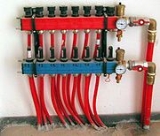
PEX
Overview
Polyethylene
Polyethylene or polythene is the most widely used plastic, with an annual production of approximately 80 million metric tons...
with cross-link
Cross-link
Cross-links are bonds that link one polymer chain to another. They can be covalent bonds or ionic bonds. "Polymer chains" can refer to synthetic polymers or natural polymers . When the term "cross-linking" is used in the synthetic polymer science field, it usually refers to the use of...
s. It is formed into tubing, and is used predominantly in hydronic radiant heating
Radiant heating
Radiant heating is a technology for heating indoor and outdoor areas. Heating by radiant energy is observed everyday, the warmth of the sunshine being probably the most commonly observed example. Radiant heating as a technology is typically more narrowly defined...
systems, domestic water piping and insulation
Electrical insulation
thumb|250px|[[Coaxial Cable]] with dielectric insulator supporting a central coreThis article refers to electrical insulation. For insulation of heat, see Thermal insulation...
for high tension (high voltage) electrical cables. It is also used for natural gas
Natural gas
Natural gas is a naturally occurring gas mixture consisting primarily of methane, typically with 0–20% higher hydrocarbons . It is found associated with other hydrocarbon fuel, in coal beds, as methane clathrates, and is an important fuel source and a major feedstock for fertilizers.Most natural...
and offshore oil
Petroleum
Petroleum or crude oil is a naturally occurring, flammable liquid consisting of a complex mixture of hydrocarbons of various molecular weights and other liquid organic compounds, that are found in geologic formations beneath the Earth's surface. Petroleum is recovered mostly through oil drilling...
applications, chemical transportation, and transportation of sewage
Sewage
Sewage is water-carried waste, in solution or suspension, that is intended to be removed from a community. Also known as wastewater, it is more than 99% water and is characterized by volume or rate of flow, physical condition, chemical constituents and the bacteriological organisms that it contains...
and slurries. Recently, it has become a viable alternative to polyvinyl chloride
Polyvinyl chloride
Polyvinyl chloride, commonly abbreviated PVC, is a thermoplastic polymer. It is a vinyl polymer constructed of repeating vinyl groups having one hydrogen replaced by chloride. Polyvinyl chloride is the third most widely produced plastic, after polyethylene and polypropylene. PVC is widely used in...
(PVC), chlorinated polyvinyl chloride
Chlorinated polyvinyl chloride
Chlorinated Polyvinyl chlorideDensity1.56 g/cm3Young's modulus 2.9-3.4 GPaTensile strength50-80 MPaElongation @ break20-40%Notch test2-5 kJ/m2Glass temperature 106 - 115 °CMelting point212 °CVicat B106 to 115 °C...
(CPVC) or copper
Copper
Copper is a chemical element with the symbol Cu and atomic number 29. It is a ductile metal with very high thermal and electrical conductivity. Pure copper is soft and malleable; an exposed surface has a reddish-orange tarnish...
tubing for use as residential water pipe
Water pipe
Water pipes are pipes or tubes, frequently made of polyvinyl chloride , ductile iron, steel, cast iron, polypropylene, polyethylene, or copper, that carry pressurized and treated fresh water to buildings , as well as inside the building.-History:For many centuries, lead was the favoured material...
s.

